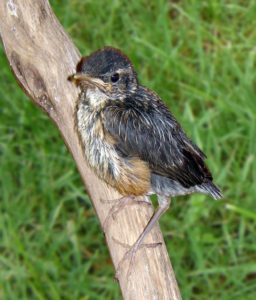Fledglings go through a period when they are just learning to fly. Depending on the species, it can take several hours or several days for them to get off the ground. Once they learn to fly, the parents gather them together and begin teaching them the survival skills they need, such as how to find food.
People often find fledgling birds temporarily stranded in a yard or on a porch and think they need help. Unable to fly, the fledglings become prey to pet dogs and cats.
This is an important transition time for these birds, and it should not be interrupted. Birds brought to rehab at this age often fail. They are not old enough to feed themselves, but they know we are not their parents and resist hand-feeding. Force-feeding places them under great stress, and they will often die.
If they are uninjured, stranded fledglings can be moved to a safer location nearby. Moving them to a nearby tree limb or herding them to a sheltered area is all the “rescuing” they need.
GET THE BOOK
Your POCKET REFERENCE GUIDE to injured or orphaned wild animals!
Print book available on Amazon – $9.95
Available on Kindle – $2.99
Free on Kindle Unlimited
When rescuin g injured wildlife, the choices you make will impact that animal’s life and possibly your own. Knowing about the risks to the animal as well as to you, your family and your pets, along with the right advice from the beginning can mean the difference between a heartwarming, educational experience and disaster.
g injured wildlife, the choices you make will impact that animal’s life and possibly your own. Knowing about the risks to the animal as well as to you, your family and your pets, along with the right advice from the beginning can mean the difference between a heartwarming, educational experience and disaster.
This informative guide teaches would-be rescuers how to identify an animal in need, capture that animal, and safely transport it to a wildlife rehabilitator.
• How to determine the status of an injured creature using easy-to-follow flow charts
• Instructions on safe-capture methods, emergency care, transportation, and finding a professional wildlife rehabilitator
